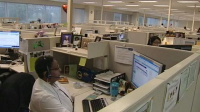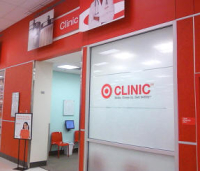While a lot of attention is being focused right now on self-driving cars, and what that might do to the millions of people (mostly men) who now make a middle-class living driving things and people around, there are two other transformations coming in the next decade that are just as important.
Education

The reason, as I wrote over a decade ago, was the nature of PC technology. By the time a system was installed and the teachers trained to use it, it was obsolete. Multimedia, Windows, the Internet, more Windows, Macs. It worked fine if you were willing to put $1,000 per year into new equipment, but you can’t do that in most schools.
The cloud is really a game changer here. With cloud, software and updates are all done centrally, all at once, and propagate to all client devices at the same time. Even an iPad can last a kid several years, and the $250/year cost can replace textbooks, making it highly affordable. Most kids can now bring their own devices to “work” anyway, and now schoolwork can follow them home.
The battered education software industry, and the education establishment, have barely begun to come to grips with what this means. For one thing, it truly turns the process of education on its head. Now, it’s the computers that can present the information, and the computers that can test mastery, while it’s the teachers who need to be doing the drills, the homework. It’s summarized by a saying from back in the 1990s – out with the sage on the stage, in with the guide at the side.

This is how you make science into play. Make the presentation a TV show, make the experiments into Mythbusters.
This part of the revolution is harder to bring to colleges. The curriculum isn’t as set there. But what’s going to happen, because of economic changes already mentioned, is that undergraduate education is going to become more akin to K-12 over time. Call it K-16. Most undergraduate courses are fairly standard. They can be taught just as K-12 classes can be. Which means colleges, in order to survive, will focus even more on research and graduate education, which is where the money is anyway.
By standardizing curricula, by using cloud to present it, by adding software to help teachers with drill, we really can deliver our grandkids the kind of educational service I once thought my kids were going to get. There is some political irony here, in that Democratic teachers’ unions are going to be a problem. But so are Republican school boards and parents’ groups, which are constantly seeking to dumb-down curricula so kids never hear anything the parents believe might make them think.
So the revolution will be messy, it will be sloppy, it will move faster in some places than in others, and it will be intensely political. But the education revolution will happen. The need dictates it, the technology allows it, and those that pursue the path will get better results for a lot less money.
Health

Every doctor we visited, over several months, had an enormous staff of clerks sitting behind terminals, telling computers to do things the computers could really do themselves, or that we could do if given a chance. Setting up appointments, handling referrals, moving test results back-and-forth, billing for insurance. Health care is run by angry clerks. But HL7 is a set of computer codes that doctors should be able to use themselves to tell insurers what they have done, and what they want to do. Insurance practices are increasingly standardized, and best practices are as well.
Medicine represents 17% of U.S. GDP, and most of that money is wasted on routine office work, or on arguments between doctors and insurers, with the doctors’ resisting best practices or trying to pull some procedure, test, or fancy drug over the insurers’ eyes, and the insurers resisting, with patients in the middle, paying both sides’ lawyers.
We have the tools, we have the standards, and we have the billing codes. It’s time to get all doctors onto hand-held pads, connected to clouds, through which they can deliver diagnoses, get test results, and deal with insurers directly. Those who don’t want to be part of the future should retire.
We know how this works.
One of the great fights of the last decade has been over primary care. Doctors fiercely resisted the Affordable Care Act, threatening to leave the field, telling all who would listen that patients would suffer, that there would not be enough primary care. They lied. There’s plenty of primary care, thanks to automation. Primary care doctors have been hauled down from their office towers and into storefronts, where they have become employees, supervisors of nurse-practitioners and physician assistants who do an increasing amount of the day-to-day patient interaction. Good.
The struggle now is to bring this new attitude up the chain, into the professions. The same companies that have achieved success on the Obamacare exchanges, and in Medicare and Medicaid contracting, are going to lead the way here. Increasingly facilities will be owned by those whose incentive is to save money, not spend it. That means better care of chronic conditions, more patient interaction with lower-skilled (but more humane) professionals, and more control over what procedures, tests and drugs are prescribed.
Insurers can either get with the program or go out of business. All the threats by United Healthcare and others to leave the Obamacare exchanges are so much hot air. All the big insurers are, in fact, creating new subsidiaries around the new business models, and those are going to dominate.
What does this mean?

During the last half decade, we’ve seen a host of progress in the creation of careers in wellness, in food service, in pet care, and in mass customization. It does take more education to pursue these opportunities – unemployment among those with “just” a high school education remains at peak recession levels.
That’s what Trumpistan is all about. It’s about people without the skills of the future telling the world they want to get off. When they talk about wanting things to be like they were before, they’re talking about wanting economic friction, about economic waste, and about the opportunity to screw their fellow man (or woman) because they can.
This is a challenge. It’s also an opportunity. We need more educated people. We need breakthroughs in medicine, in renewable energy, in a host of things that require business models to make work.
The next decade is going to be a decade of business models, both public and private, aimed at solving big problems and giving our kids meaningful, rewarding careers that last a lifetime.











